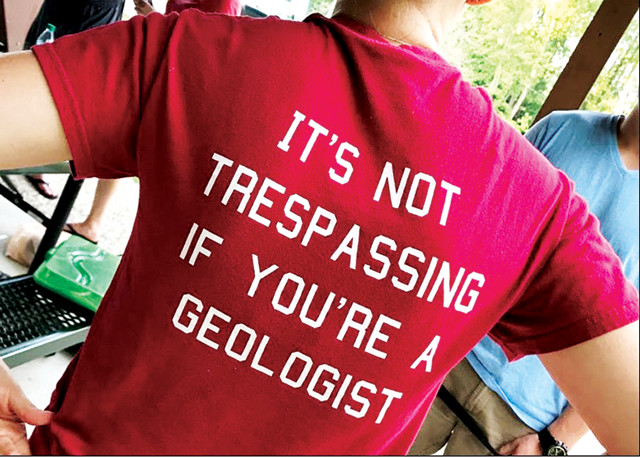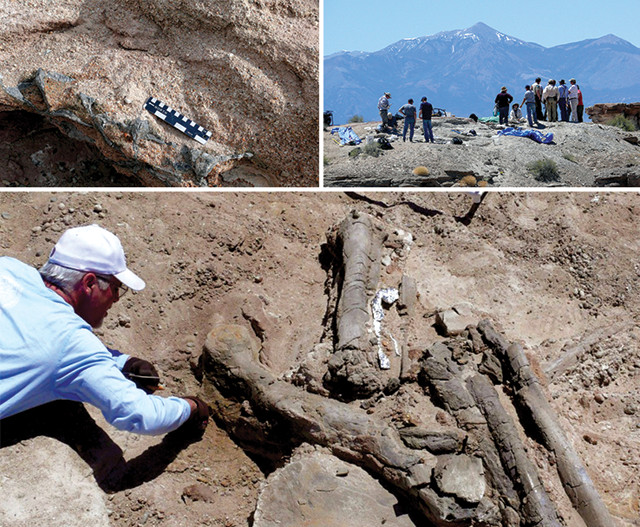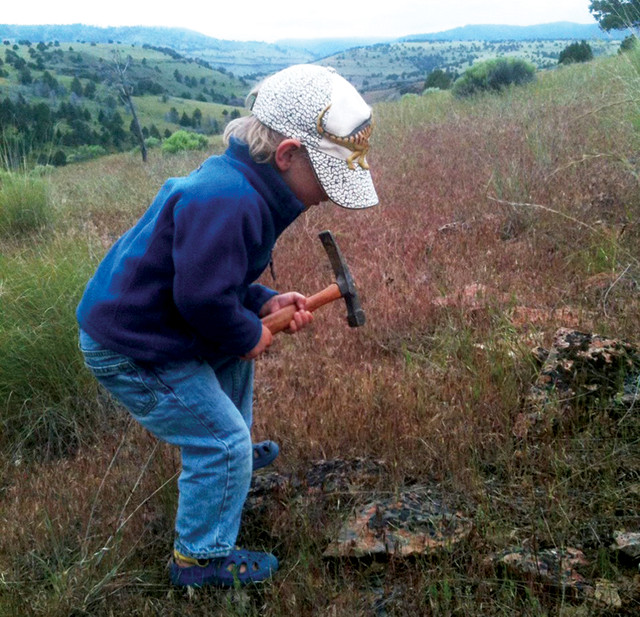
by Scott E. Foss Tuesday, March 19, 2019

This shirt is intended to be funny, but we geoscientists should respect both physical and ethical boundaries when working in the field. Credit: Scott E. Foss.
In May 2015, five people associated with a college field trip, including students, stole 60 pounds of dinosaur bones from Bureau of Land Management-administered land in Utah. The bones were recovered, the offenders were charged with varying degrees of theft and they eventually pleaded guilty. Luckily, such egregious incidents are uncommon, but smaller instances of vandalism by professional geoscientists are more common — for example, cutting something out of an outcrop on national park land.
I used to work in a national park, and I remember how the staff would groan when we learned that a university geology field camp was setting up in the campground. Most came and went without incident, but there were enough issues that park employees developed a negative perception of geologists. Instructing future geoscientists in the field is a hallmark of geoscience professions, but we must do a better job of teaching the ethics of fieldwork.
We should integrate the ethical principles of professionalism, proper scientific methodology and respect for others into our field practices, and hopefully impart these practices to students. There are three outstanding variables to ponder when considering the ethics of fieldwork: values, integrity and perception. Geoscience fieldwork is very visible to the public, so it is important that we lead by example.
One important part of ethical field practice is to consider all possible uses of the land. Different people recognize different uses of the land as important. Each land user (including you) typically believes his or her use, or immediate pursuit, is the most important or most justified use of the land. And we each feel that our attitude toward the land is the correct one. A little of that sentiment is OK: Healthy confidence allows us to defend what we do and why we do it. But if we’re too rigid in our opinion, we can’t appreciate, much less respect, the views of others — and respect for others is a core tenant in any ethical framework.
Various land uses — recreation, resource extraction, conservation, scientific investigation — may often seem at odds, but geoscientists have to respect the values of others and how they use the land. That does not always mean adopting their values and practices, but it does mean making an honest effort to understand, and when appropriate, accommodate other points of view. We interact professionally and personally with the land and are intricately involved in all of its uses. As a profession, how we treat the land is not just a model for our peers and students, but it also sets an example for society’s attitude toward the land.
So consider the land, and ask yourself how your work will impact the environment. Ask yourself what makes your work worth doing and how it will contribute to knowledge, or benefit yourself or society. Hopefully your contributions are greater than any negative effects your work might have — even if we’re talking about something as seemingly minor as cutting down a bush or drilling a core hole in an outcrop. Don’t justify the impact of your work by comparison. For example, a strip mine over the hill may be extracting resources and leaving a gash in the land, but you shouldn’t use that as justification for the damage you might do.
It is important to maintain the highest levels of professionalism while working in the field. This includes using sound field methods, representing yourself and your institution honestly and following basic conservation principles, including collecting only what is necessary to address an appropriate research question or educational objective.

At the Hanksville-Burpee Dinosaur Quarry in Utah, hundreds of dinosaur bones have been found, including limb bones (left) and neck vertebrae (above left) of different species of sauropods, many of which have been excavated by volunteers (above). Countless geologic field trips to this quarry have occurred without problems, but in May 2015, several field trip attendees excavated and stole 60 pounds of dinosaur bones. Credit: all: Utah Geological Survey.
One of the issues of integrity we at the Bureau of Land Management see is related to how geoscientists represent themselves and their goals, especially regarding permissions. Make sure you get permission to access the land where you’re working, whether from a landowner or agency. When seeking permission, make sure you represent yourself accurately. Did you tell the whole truth about who you are, your credentials, your institutional affiliation, what you will be doing, and what you will do with the data and samples you collect? That’s the “before.”
Next, is the “after.” So, you collected a ton of data and your students learned a lot. But what will happen to the data and the collections? Did you report back to the landowners about what you discovered? Even if they don’t understand the minutiae of your project, they do understand and have an investment in their land. They also may have ownership over anything found on their land. You might be thinking, “Wouldn’t it be great if they donated the fossils to a museum, preferably my museum?” Well, of course it would, but it’s theirs to give, not yours. Don’t withhold anything you know about the collection from a landowner. Show them anything you found and tell them about it. Working with private landowners is a partnership, so it is ideal when a copy of the research results (resultant paper, abstract or professional presentation) is shared with the landowner, even if it’s years later.
The same is true for work on public lands, only the landowner is the general public, so if a permit is needed, get a permit. If you have a permit, make sure you provide an accurate and timely report, including details of where you actually worked, when you were there, what you discovered, what you collected and where those collections are now. If collections need to be transferred to a museum or repository, make sure that they are transferred as agreed and on time. If there is a need to deviate from the terms of the permit, notify the issuing agency ahead of time and have the permit revised.
Whether it is hubris, premeditated deceit or just an accident, lapses in disclosure lead to most problems caused by geoscientists in the field.
Scientists and students in the field must maintain a clear idea of what they are doing and what their work might look like to others, especially to those who do not share the same values. Always consider how you are representing the geoscience community and what you are teaching others by your example. Be approachable, be respectful and be friendly. Scientists, including geoscientists, are often described as being aloof, arrogant or out of touch (aka the Ivory Tower). Don’t contribute to that stereotype.

Kids — and geoscience students — should get to experience the joy of hammering a rock, but it's incumbent upon their teachers to help them appropriately choose which rock to strike. Credit: Scott E. Foss.
Next, think about what you’re teaching others by your example. Student field trips are where best (and worst) field practices are learned. So it’s important to respect outcrops, which means taking only what you need — and what is permitted — for your scientific inquiry or educational objective. Admittedly, there is something primal and satisfying about feeling the reverberation of a rock hammer striking rock. The sound betrays the density and cohesion of the surface. The dust carries odors, sometimes sweet, sometimes acrid, that last in the deepest recesses of the mind. There’s even an occasional spark! And, of course, learning the proper use of the tools of the trade, including rock hammers, requires repetition and practice.
Geoscience students should not be denied the tools of the trade, nor should they be denied the experience of striking a rock with a hammer, but use prudence when choosing which rock to strike. Ask yourself if they need to learn on the publicly exposed face of an outcrop, along a highly used trail, or in a municipal, state or national park. Does it need to be on Native American rock art? (No!) Do you need to smack a rare, or even not-so-rare, fossil? (No!) Professors: Respect the outcrop. Students: Put down the hammers, listen to the instructor, respect the land and then, when appropriate, find a cobble or other appropriate surface on which to practice what will hopefully be part of your future profession.
Developing best practices and ethical guidelines for instructing students in the geosciences should be encouraged. I propose that geoscience professional societies take this lead and develop their own sets of ethical standards. University College London has created a common-sense and wide-ranging set of standards that could serve as a model: www.ucl.ac.uk/earth-sciences/sites/earth-sciences/files/fieldwork_code-of-practice.pdf.
There are many ways we can improve our ethical conduct in the field, both as individuals and as a discipline. I offer a few suggestions that apply to all geoscientists: Respect the values of other users of the land; consider the impact that your work will have on the environment; and teach by example.
All of us have made ethical lapses in both the field and in life. No one is perfect. The intent of this piece is not to point fingers, but rather to inspire each of us to be more vigilant and better leaders in terms of applying ethical field practices.
Being a geoscientist should be fun. However, in an increasingly crowded environment where development, recreation, preservation and competing scientific endeavors share space, we must take care to recognize the differing values of the users around us, use integrity when making choices and always be mindful of how we are representing ourselves, our institutions and our profession as a whole.
© 2008-2021. All rights reserved. Any copying, redistribution or retransmission of any of the contents of this service without the expressed written permission of the American Geosciences Institute is expressly prohibited. Click here for all copyright requests.